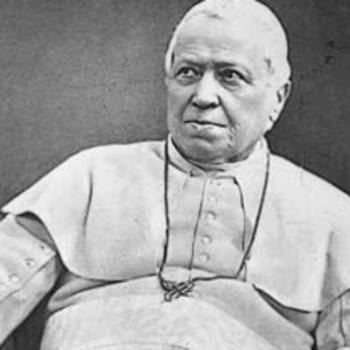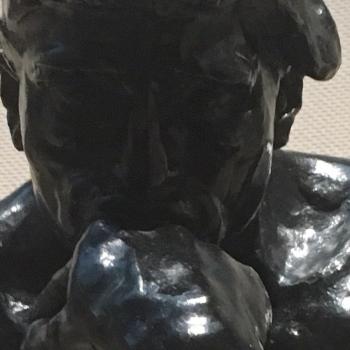
Very early in this chapter, John Calvin is already making claims that are painfully easy to disprove. He has grown desperate. “What is the direct aim of the mass,” he cries, “but just to put Christ again to death, if that were possible?” I’m glad he admits it’s not possible. That’s a first. Just before this, Calvin claimed that the Mass “overthrows the cross of Christ,” but nowhere says that that’s not possible. As Calvin grows more wreckless in his charges, he also becomes more apt to season his wrecklessness with caution.
But I want to look at this claim that the Church’s direct aim in the Mass is to put Christ to death another time. You’d think we were processing him down the aisle in his crown of thorns and nailing him to the crucifix. Calvin’s not so foolish as to think that. What he means is that if the Mass is a sacrifice, it must entail crucifying Christ all over again. Now, of course, Catholics don’t do this, and so if they don’t, the Mass can’t really be a sacrifice as they claim it to be. It would have been clearer had Calvin just said it that way. But Church! You say the Mass is a sacrifice. But you can’t have a sacrifice without blood. Hebrews says so. Unless you’re putting Christ back up on the cross, which you couldn’t do if you wanted, it’s no sacrifice.
This is an argument about the meaning of a word and the exegesis of a text in Hebrews. Calvin, however, doesn’t say those words above. Instead he says: But Church! Your direct aim—I said direct aim—is to crucify Jesus all over again. It’s what you mean to do. Yes, I said it.
•••
So we go once more to the Church texts to disprove this nonsense.
- The Council of Trent says that Christ “offer[ed] Himself once on the altar of the cross unto God the Father.” The sacrifice of Christ was “once to be accomplished on the cross.”
If the Church says that Christ offered himself once and the sacrifice was accomplished once, the Church can hardly be said to have a “direct aim” of killing Jesus all over again.
- The Catechism of Trent says the same thing: “Christ was offered once to exhaust the sins of many.” Again: Christ was “offered once on the cross.” Again: “Christ our Lord … offered Himself once only.”
(An amusing aside here. I recall an anti-Catholic sermon of Dr. John MacArthur in which he read these very truths straight from the book of Hebrews, and he kept emphasizing the word “once” as though it were the authoritative bludgeon against Catholic error. But the Council and Catechism of Trent affirm the same thing.)
- The subtitle of one full section of the Catechism of Trent is: “The Mass Is The Same Sacrifice As That Of The Cross.”
Let’s linger over this. Here’s the full text, with my own [asides].
We therefore confess that the Sacrifice of the Mass is and ought to be considered one and the same Sacrifice as that of the cross, for the victim is one and the same, namely, Christ our Lord [You can’t sacrifice the same victim more than once. We don’t need Calvin to tell us this; the Church does.], who offered Himself, once only, a bloody Sacrifice on the altar of the cross. The bloody and unbloody victim are not two, but one victim only, whose Sacrifice is daily renewed in the Eucharist, in obedience to the command of our Lord: Do this for a commemoration of me.
The sacrifice is renewed, not done all over again. Words mean things, and the Church can hardly have the “direct aim” of doing something that its Magisterial and catechetical texts deny.
•••
John Calvin knows all this. “I admit they are ready with an answer!” he cries. “They even charge us with calumny!” (You don’t say.) “They say that we object to them what they never thought, and could not even think.” (Yes, because you’re making all this up.) But “whether they mean to slay him, we regard not.”
Wait. Wait. First, Calvin says that the Church’s direct aim—remember?—was to crucify Christ all over again. Now, he says it doesn’t matter whether they mean to or not. I don’t care about such things. That’s what they’re doing anyway, because it’s “the absurdity consequent on their impious and accursed dogma.” So it doesn’t matter what the Church claims, or what the Church’s texts actually say, because I say otherwise, and I’m John Calvin. “Though they insist a hundred times that the sacrifice is bloodless,” I know it’s not.
Right. And why is Calvin so sure of this? Has he seen pools of blood underneath the altar, or dripping down from the crucifix and into the sacristy? In fact, whatever is going on at Mass, it’s certainly bloodless, unless someone gets a papercut from the hymnal.
And Calvin surely knows all this. The whole point of his rhetorical overkill and misdirection here is to prove, not that the Mass re-crucifies Christ, not that Catholics are trying to re-crucify Christ, and not that there’s blood everywhere and the police will soon show up with crime tape. He’s trying to prove that the Mass is not a sacrifice at all, because there’s no such thing as a bloodless sacrifice. And in an effort to prove this, he quotes Hebrews 9:22: “Without shedding of blood is no remission.”
•••
So let’s talk about Hebrews 9:22. The Church has no fear of this text because it means exactly what it says. Sacrifice requires the shedding of blood, and that is precisely what took place on Calvary. I need not give a whole list of citations to prove this, because no one denies it.
In fact, the dispute really hangs on another claim, which is that the sacrifice at Calvary and the sacrifice at the Mass are the same sacrifice. The Church hardly denies Hebrews 9:22, because it agrees that Christ shed his blood at Calvary. The Sacrifice of the Mass is the same sacrifice.
But Alt! Calvin may have retorted. How then does the Church say that the Sacrifice of the Mass is bloodless if it’s the same sacrifice as the bloody sacrifice on Calvary? It can’t be bloodless and bloody at the same time!
Well, actually, now that you mention it, it can. That’s precisely what the Church teaches. The Sacrifice of the Mass is unbloody in its accidents but bloody in its substance. For the Church teaches—Calvin knew this—that the Eucharist becomes the body, blood, soul, and divinity of Jesus Christ. The Catechism of Trent says:
[T]he Holy Eucharist … contains both, and whatever is included in the idea of both, the Divinity and humanity whole and entire, consisting of the soul, all the parts of the body and the blood, all of which must be believed to be in this Sacrament.
So the Eucharist is the blood of Christ under the unbloody appearance of bread and wine. Catholics have no trouble with Hebrews 9:22 at all.
And Calvin would have done better to try to refute the Church’s actual claims than to make up claims the Church does not make and attribute them to her anyway. That’s been the anti-Catholic schtick from the beginning.












